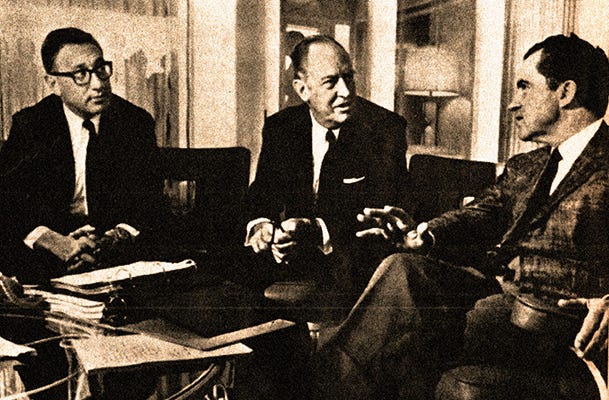In March 1969, former president Dwight Eisenhower was in a private suite at Walter Reed Hospital in Bethesda, Maryland. He had spent much of the last year there, having suffered his fourth heart attack in August 1968. The 78-year old, still known affectionately as Ike, was mentally sharp as ever, though his body was frail. Those closest to him knew his time was short.
Eisenhower shepherded America through the 1950s, and his presidential legacy has grown in popularity in recent years. In the 60s, though, Eisenhower was criticized for not doing enough to support civil rights during his time in office. This did not endear him to the younger generation. For those old enough to remember Ike as president, he was a relic of another time, a symbol of the Establishment.
Older Americans remembered Ike’s presidency more fondly. He brought an end to the Korean War. He also rejected aggressive calls by some around him to get more involved in Southeast Asia after the French defeat at Dien Bien Phu in 1954.
Every president that followed Eisenhower actively sought his counsel, even though none of them heeded his warning about the military-industrial complex. He did his best to offer ideas as first Kennedy, then Johnson got sucked into the jungles of Southeast Asia. Now, Richard Nixon, the man who had served as Ike’s loyal VP for eight years, was trying to get America out.

Nixon’s strategy for getting out of Vietnam relied heavily on making South Vietnam more self-reliant. America could feel better about leaving the field of battle if the South could stand up to the communists on their own. To get there, they had to be free of the Viet Cong insurgency in their midst so they could focus on the North Vietnamese Army (NVA) regulars.
The best way to do this was to cut Viet Cong supplies. And the best way to do that was to bomb the living hell out of the Ho Chi Minh Trail.
The trail was a network of paths that ran hundreds of miles along the shared borders of Vietnam, Laos, and Cambodia. Since 1959, the North Vietnamese moved men and materiel along the trail to fuel the insurgency in the South and support the guerilla war against American troops in the field.
Nixon wasn’t the first president to consider bombing Cambodia. Lyndon Johnson had investigated the option. Militarily, it would have dealt a significant blow to the NVA. Diplomatically, though, it would be seen as bombing a neutral country.
Cambodia wasn’t quite neutral, though. And North Vietnam did not respect that fragile neutrality. They ran through the jungle confident the locals were not going to stop them. Johnson’s advisors convinced him that expanding the war into Cambodia was not worth the effort.
Nixon arrived at a different conclusion. He believed that bombing the North Vietnamese presence in Cambodia was a necessary step. It would give some relief to the South, and it might get the North Vietnamese to the negotiating table as well.
And what did the Cambodians think of all this? Cambodian leader Norodom Sihanouk had already agreed to turn a blind eye to so-called “hot pursuit” raids into Cambodian territory by U.S. forces in pursuit of retreating Viet Cong. And he was not happy with the growing presence of the Viet Cong in his country. Sihanouk was not terribly popular and he feared the revolutionary presence might give disgruntled locals bad ideas. Sihanouk’s tacit acceptance of “hot pursuit” raids was later given as a reason for the legality of the operation.
Nixon almost bombed Cambodia in an angry fit on February 23, 1969. The North Vietnamese had launched a major offensive during a bombing halt that cost American lives. Nixon cursed them for their lack of faith and ordered the bombing of targets along the Ho Chi Minh Trail in Cambodia. Secretary of State William Rogers and Secretary of Defense Melvin Laird talked him out of it. It was one of the last times they would ever be consulted on that level again. The two men were eventually frozen out of the decision-making loop altogether in the months and years to come.

On March 14, another North Vietnamese attack struck urban centers in the South. Nixon sent out another bombing order, and he made sure this one was “not appealable.” The State Department was not to be notified of the bombing until it was too late to call back the planes. And the whole operation was to be kept secret from the press.
On March 18, 1969, Operation Breakfast sent 48 B-52 bombers into Cambodia to drop 4,200 tons of bombs on a suspected North Vietnamese base. Bombings of other bases followed in the weeks to come with Operations Lunch, Snack, Dinner, Supper, and Dessert. 3,800 missions dropping over 100,000 tons of bombs. How do you keep that secret?
Nixon knew he couldn’t keep Operation Menu quiet forever, and he predicted a bloodbath in the press once the story broke. He just needed enough time to give the South Vietnamese a chance to build up a decent defense. And to flex enough muscle to drive the North Vietnamese to negotiate a settlement.
On March 28, 1969, Dwight Eisenhower died. He lived long enough to see the number of Americans killed in Vietnam surpass the 36,000 who died in the Korean War 16 years earlier. It’s a milestone reported on in newspapers across the country, along with announcement of the former president’s death.

3 thoughts on “Why Nixon Bombed Cambodia”